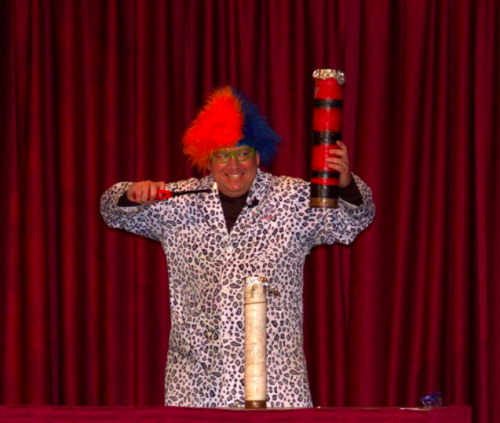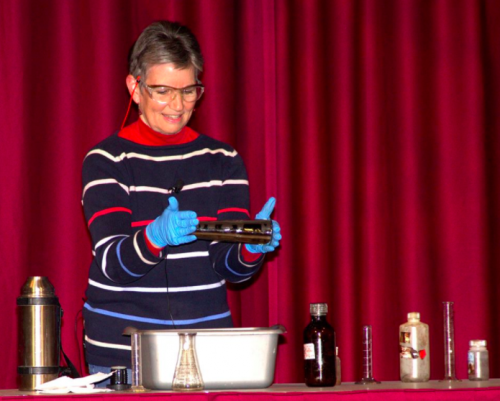
Henry Charlier, aka Dr. Picklestein.
Twenty years ago, before his tenure at Boise State University, Henry Charlier brought a pickle back to life to the fascination and awe of his local church group. On that day, the quirky chemistry character Dr. Picklestein was born.
When Charlier joined Boise State as an associate professor of chemistry in 2000, with his department’s blessing, he continued his evening and weekend routine as Dr. Picklestein. For years, he wowed these audiences – from K-12 students to college students, parents and even families at homeless shelters – with his playful demeanor, colorful uniform and clever chemistry tricks. These tricks included demonstrating the energy released when you ignite liquid oxygen in a Cheeto, making cornstarch dance on a speaker, and many experiments involving liquid nitrogen.

Karen Hammond, aka Lady Argentum.
In fact, the popular demand for Charlier was so great that Boise State’s Department of Chemistry even acquired him a side kick in 2010: Karen Hammond, also known as Lady Argentum, a student support manager in the department. Lady Argentum’s signature trick is turning clear glass bottles silver, which she then gives out to lucky audience members as mementos. (Argentum, of course, is the Latin word for “silver.”)
The duo’s popularity only continues to grow. Their next public appearance is scheduled for Boise State’s College of Engineering Feb. 3 Engineering and Science Festival where they will perform throughout the day.
“In 2016, we went to 51 locations and did 75-80 shows,” Charlier explained. “That year, we saw 8,500 students.”
Since 2011, the duo has reached over 36,000 students, along with parents and teachers, through their demonstrations. They have averaged three-to-four shows a week at their busiest, and performed at more than 265 locations across the state. And all shows are free to their enraptured audiences, thanks to continued funding from the Department of Chemistry and College of Arts and Sciences. (The pair also accept donations for materials – to donate, visit https://give.boisestate.edu/ and search for “Chemistry And Biochemistry STEM Outreach Fund” or fund ID AR295.)
“We perform at birthday parties, libraries, school assemblies before STEM nights,” Hammond explained. “We go to preschools, daycares – you’re never too young to gain an appreciation of science. We play with liquid nitrogen and balloons.”
“We’ve even done performances for young adults with special needs and with cognitive disabilities,” Charlier added. “These were college-aged kids; I thought ‘why not invite them to campus?’ So they came, they went in the lab, we did demos and hands-on stuff. The highlight for me was a guy named Dave with Down Syndrome who referred to me as his professor. I nearly teared up. Science is for everybody, it doesn’t really matter if you’re going to be a scientist when you grow up.”
Charlier has been working as Dr. Picklestein for so long that children once entertained by his experiments are now his college students, or even teachers in their own right who ask him to come give demonstrations in their classrooms. Just as he is out shaping kids’ perceptions about science, he said that his motivation for introducing ensuing generations of kids to STEM was shaped by the powerful words of a colleague – Donna Llewellyn, the executive director of Boise State’s Institute for STEM & Diversity Initiatives.
“Donna said to me once, ‘Everyone has the right to have their lives enriched by science, just like the arts.’ That, for me, was a game changer,” Charlier said. “And if you want to be a scientist, great!”
BY: CIENNA MADRID PUBLISHED 1:05 PM / JANUARY 17, 2018